WORLD CLASS COACHING
Scoring Goals from High Pressure Defending
By Luca Bertolini
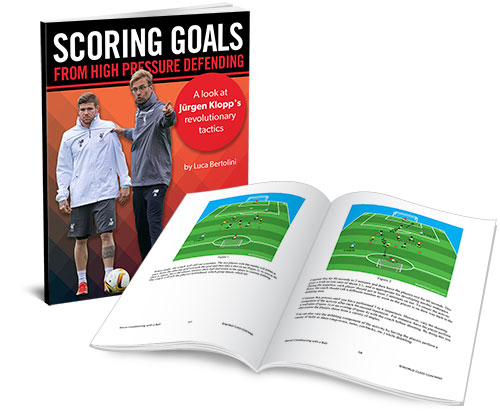
TABLE OF CONTENTS
Part Three
COUNTER ATTACKS
COUNTER ATTACKS
Looking at Klopp's history as manager, “no playmaker in the world can be as good as a good counter-pressing situation;” this means that a side to side pass move often requires slow build up play, and that, on the other side, the counter-pressing can create chances within seconds.
The organization behind it is the key, as Klopp’s pressing isn’t simply a closing down but a group of players all functioning as one to smother the opposition, as they look to launch a counter-attack.
The first interesting factor is that the team recognizes when they have enough players close to the ball, who are able to press the opponent with the ball and the area around it.
The players who are not involved in the pressing around the ball must ensure that a potential long kick from one of the opponents can be controlled and they must be able to press again a second receiver, if the first pressure doesn't work. They also have to be in a position to potentially win or intercept a wrong pass from the counter pressure, to recover the possession with the chance of organizing a counterattack of their own.
All the other players placed on the other side of the ball recover immediately and quickly, either to join the pressing swarm or to recover goal side of the ball and to be placed in a position to be one of the covering or interceptor players; if these players are in possession, usually the moves are built up with pass combinations rather than with direct counterattack.
As we already found out in the first part, an important objective of the high pressure is to close the short pass lines and to force long ones toward the midfield area; the same happens when Liverpool's forwards are placed inside or near the opponent’s penalty area.
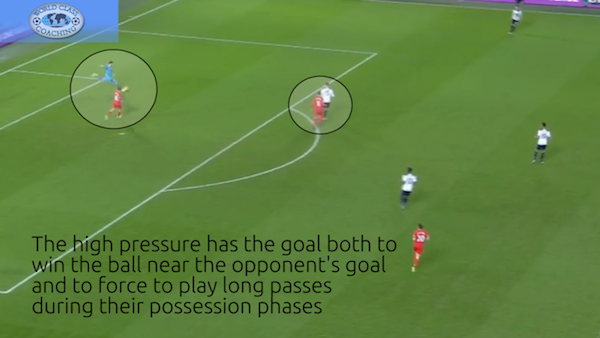
After the forced long pass toward the middle third, win the second times and the wandering balls.

If the ball is kicked or arrives toward Liverpool's defense half of the field, the individual duels become very important, to ensure the possession.

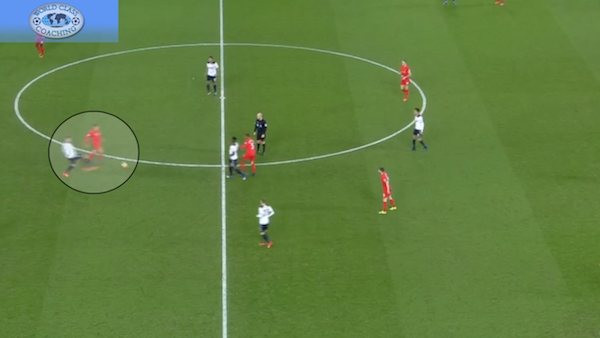
A vertical pass is then played toward an available space to finish at speed thanks to a running free teammate, who is splitting the pitch to attack the goal. This last receiver is a player who was not directly involved in the prior pressing phase.
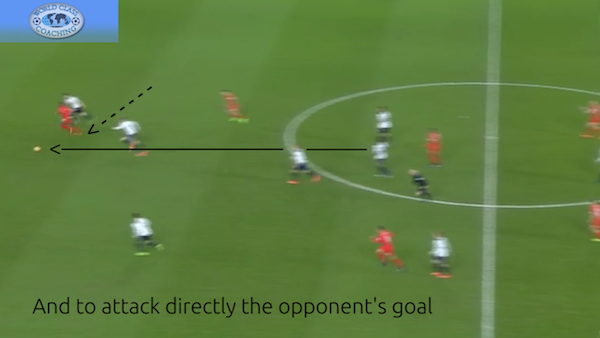
This move is an example of indirect pressing action, where Liverpool's players don't put direct pressure on the ball, but they just send the opposition's possession phase backward and they force the goalkeeper to kick a long pass.
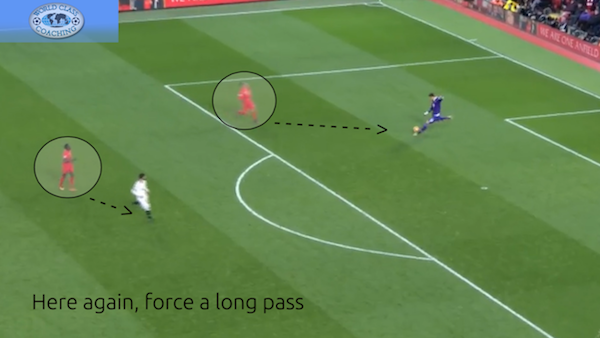
One of the center midfielders and even the center backs must ensure the possession in the middle third, to leave the ball away from the own goal, not to lose yards on the field; here it's very important to be in numerical advantage against a potential receiver of the opposition team.

And, again, one player is not directly involved in the pressing situations, but he's placed and ready to receive a forward decisive pass to counterattack and finish.

The forwards, who were pressing on the goalkeeper before, are now ready to finish as they are already near the penalty area.
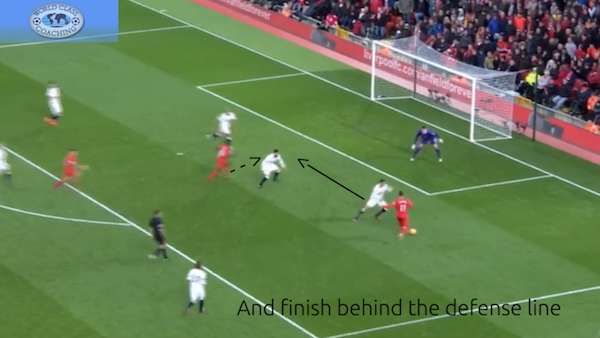
If the opponent’s defense is still balanced, or at least able to stay placed inside the first third with a safe number of players...

...the vertical passes are kicked always between the defender’s line first...
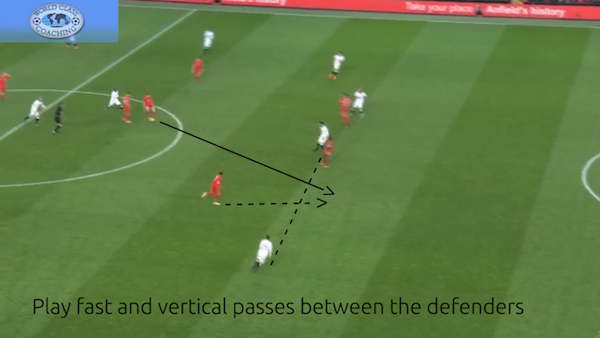
...and the last pass to finish is kicked behind the last line and in front of the goal; the receiver has to be able to look at the goal to score in, running without the ball between the defenders, to be placed in positional advantage.
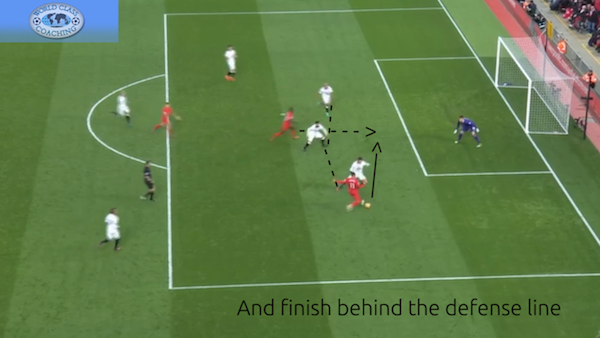
This is an example of direct pressure against the opponent, with the aim of being in numerical advantage (3 v 1) to recover the possession close to the penalty area. To close the forward pass lines and to force back passes to the opponents, if the possession can't be recovered, are useful tactics, even when the possession is lost in the final third, after a side by side play and the team is placed high on the field.
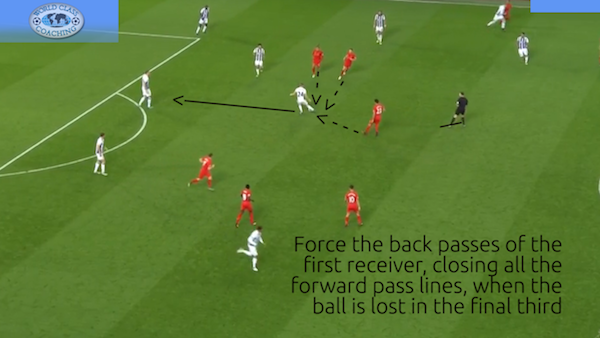
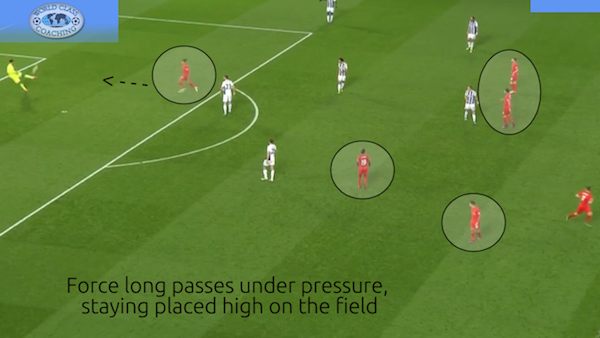
If the opponents make technical or positional mistakes, Liverpool is able to counterattack very quickly, being already near the goal.
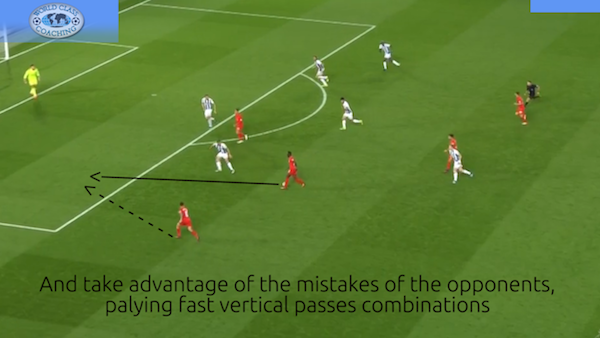
When Liverpool is pressed inside the defense half, playing throw-ins or free kick, the possession is lost on purpose, playing a long ball first, and then attacking the first receiver in the middle or final third while he’s receiving.
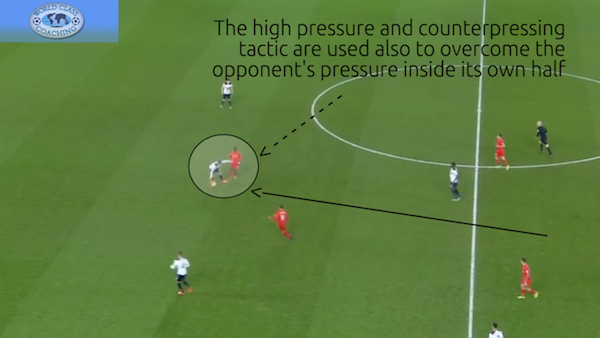
Once the possession is recovered, fast counterattacks are carried out, attacking the goals with all the advanced players to shoot...

...and to win the second times of the ball or the rebounds of the goalkeepers.
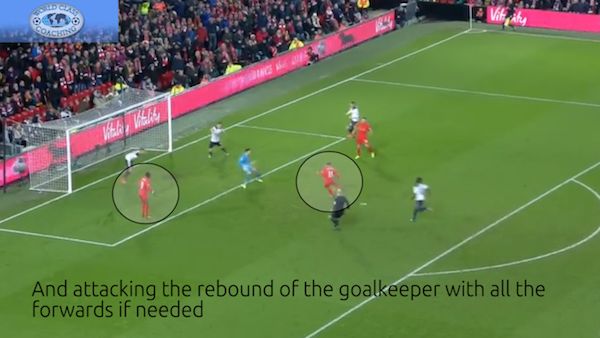
One of the most interesting characteristics of Liverpool is the skill to recognize and to take advantage of the potential situations that develop when the opponents lose the ball. Usually the three advanced midfielders and the center forward are involved in the moves together with one of the center midfielders.
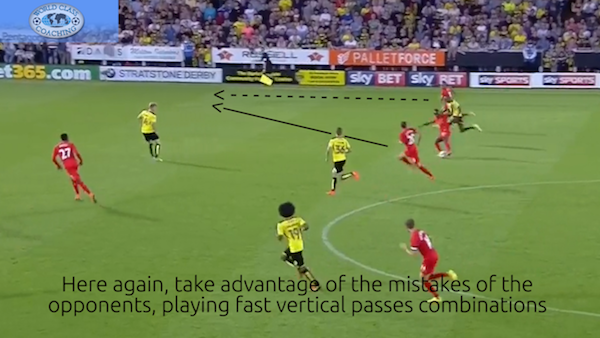
As a teammate wins the ball, all the others which potentially can arrive near the goal quickly, attack the penalty area vertically while the player with the ball dribbles up to send a decisive pass and finish.
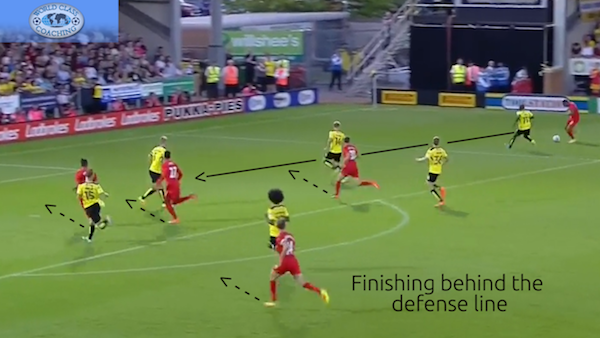
All of them are in positional advantage as they can run freely looking at the ball and in front of the goal...
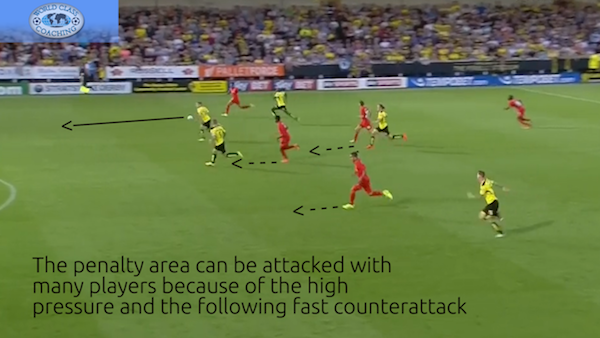
...and being often in equal number or numerical advantage to finish.
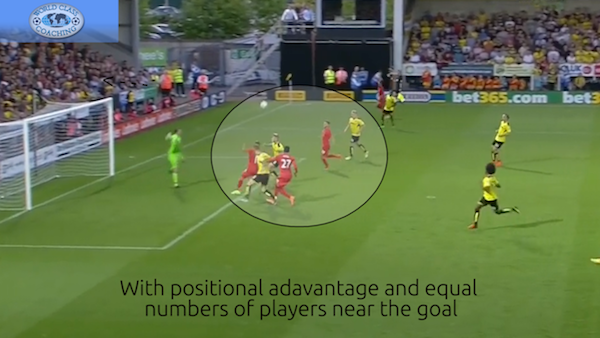
If the other team creates a strong side to put pressure with high density of players, while Liverpool is trying to build up from the back, the side of play is switched through long balls.
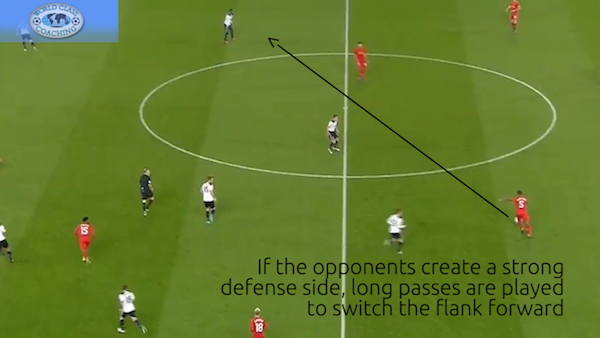
If the opponent arrives on the ball first, he’s immediately attacked on the first control, to win the ball and take advantage of the weak side to finish.
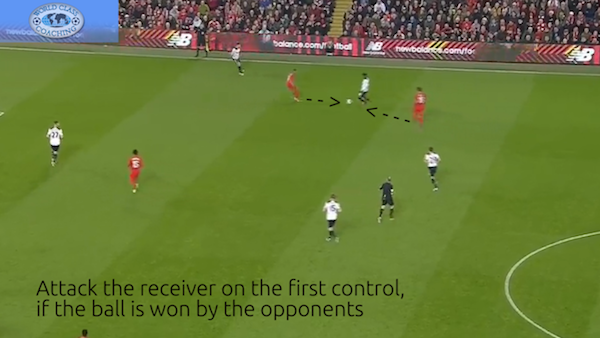
This way Liverpool is always in positional advantage even if the spaces are recovered and the density is restored again near the ball.
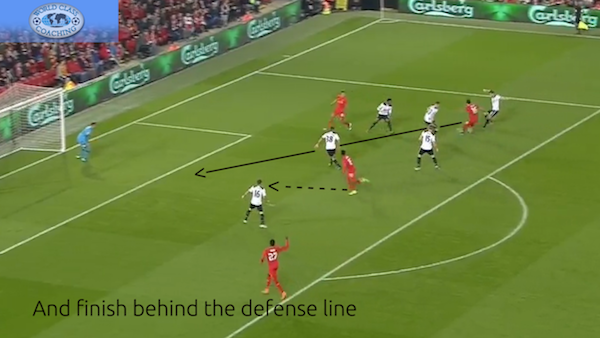
Forward passes are the main objectives of the positive transitions once the ball is recovered back.

Play forward and finish behind the defense line with fewer number of touches of the ball...

...and leave the defenders on late every time it is possible.
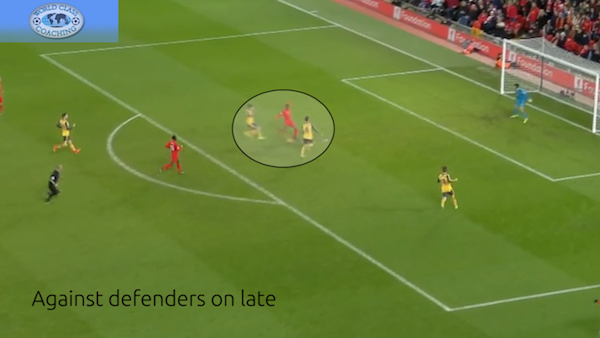
Even when they can't stay placed high on the field, and Liverpool has to defend inside the first third, the idea is always to defend forward, to attack the opponent with the ball and the latter while it's being passed. This is a team strong pressure that allows Liverpool not to lose the basic defense formation inside the first third, not to open spaces...
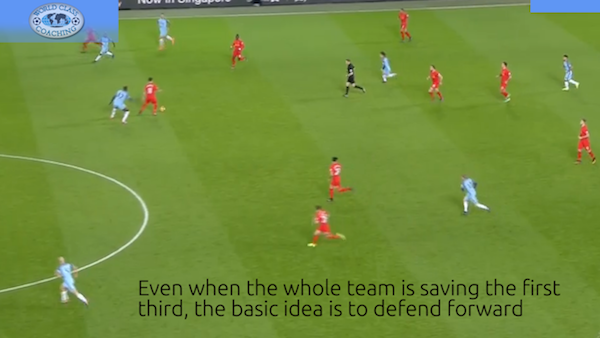
...and to find available ones to counterattack as the ball is gained back.

When all the forwards can attack the final third, after fast building up of the moves in the middle third, and they are able to look at the opposition's penalty area and goal, they can be considered in positional advantage.
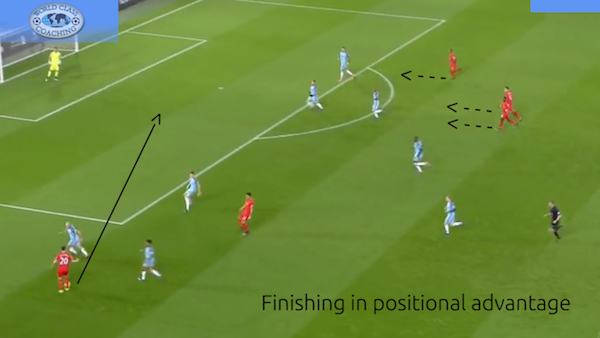
The positional advantage is always preferred over the numerical advantage during the finishing stages, as it ensures more clear chances to score and to keep the team balanced all over the field. A 1 v 2 duel near the ball, just out of the penalty area, can be noticed before the cross pass; and then a 1 v 1 duel on the ball after the cross pass too, but the forward can look at the goal, running toward it. The defender is wrongly positioned against him and all the others are on late. This way they can take advantage of a 4 v 8 (+ goalkeeper) outnumbered duel in the final third.
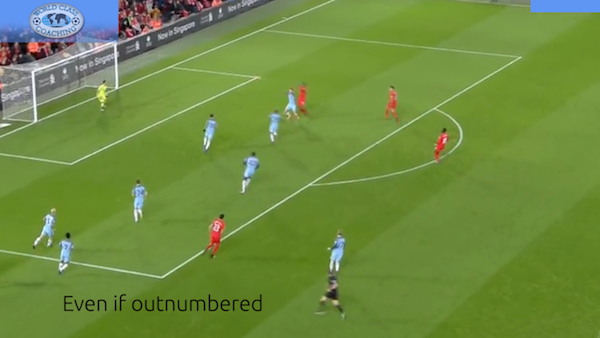
A general 3 v 7 (+ goalkeeper) situation inside the penalty area can be seen; and there is a 1 v 1 duel on the ball and a 2 v 4 duel in the center also. One forward is placed among the defenders without being directly marked and a second one is running toward the goal, looking at it and being able to receive with the right time to finish.

The goal can be scored even if the forwards are generally outnumbered (4 v 8 + goalkeeper), but with a strong positional advantage in the 1 v 1 + goalkeeper situation near the opposition goal.



